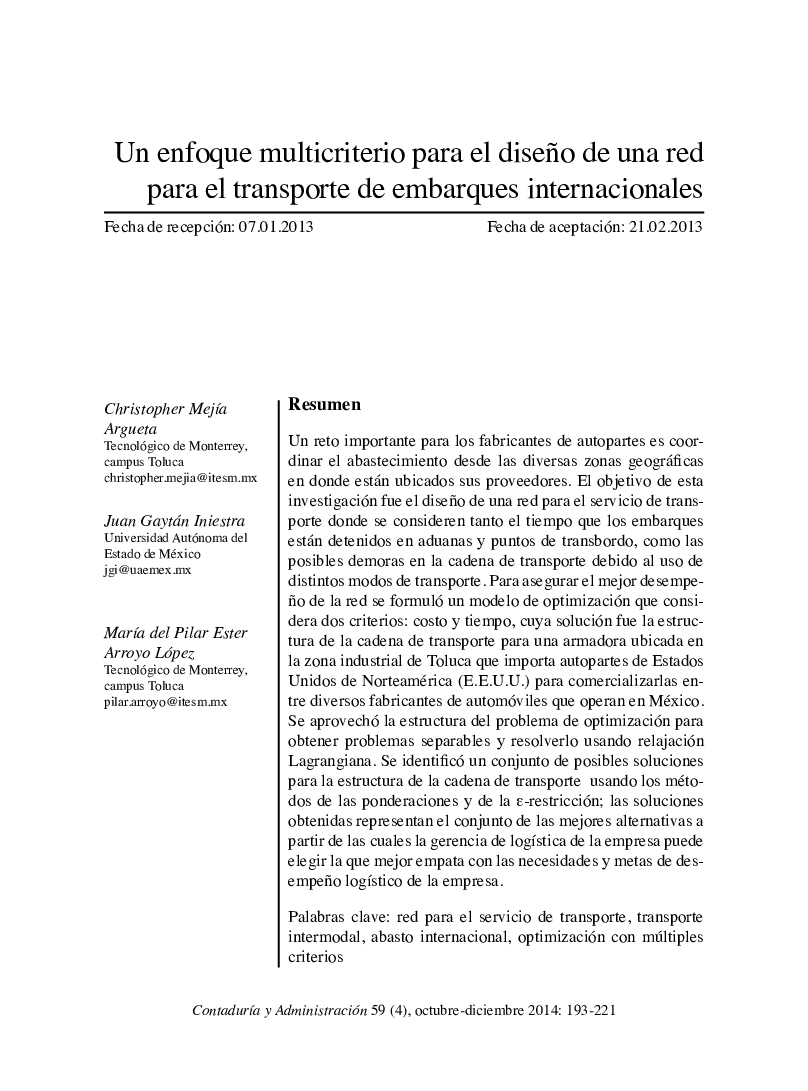| Article ID | Journal | Published Year | Pages | File Type |
|---|---|---|---|---|
| 1004554 | Contaduría y Administración | 2014 | 29 Pages |
ResumenUn reto importante para los fabricantes de autopartes es coordinar el abastecimiento desde las diversas zonas geográficas en donde están ubicados sus proveedores. El objetivo de esta investigación fue el diseño de una red para el servicio de transporte donde se consideren tanto el tiempo que los embarques están detenidos en aduanas y puntos de transbordo, como las posibles demoras en la cadena de transporte debido al uso de distintos modos de transporte. Para asegurar el mejor desempeño de la red se formuló un modelo de optimización que considera dos criterios: costo y tiempo, cuya solución fue la estructura de la cadena de transporte para una armadora ubicada en la zona industrial de Toluca que importa autopartes de Estados Unidos de Norteamérica (E.E.U.U.) para comercializarlas entre diversos fabricantes de automóviles que operan en México. Se aprovechó la estructura del problema de optimización para obtener problemas separables y resolverlo usando relajación Lagrangiana. Se identificó un conjunto de posibles soluciones para la estructura de la cadena de transporte usando los métodos de las ponderaciones y de la ε-restricción; las soluciones obtenidas representan el conjunto de las mejores alternativas a partir de las cuales la gerencia de logística de la empresa puede elegir la que mejor empata con las necesidades y metas de desempeño logístico de la empresa.
One of the important challenges for manufacturers and distributors of autoparts is the coordination of multiple sourcing areas where their international suppliers are located. The objective of this research is the design of a service transportation network that takes into account the time shipments are held at customs and transshipment terminals, as well as the possible delays due to the use of different transportation modes. To assure the best performance of the whole transportation network, a bi-criteria optimization model was formulated, the two criteria considered were cost and time. The solution to the model was the structure of the transportation network to be used by a manufacturer of auto parts located in the Toluca industrial zone; this firm imports auto parts produced by suppliers located in the United States (E.E.U.U.) and commercializes them among multiple automakers. The structure of the optimization problem was analyzed to obtain a convenient separable arrangement and then the problem was solved by using Lagrangian relaxation. A set of possible efficient solutions for the structure of the transportation network was generated by using the weighting method and the ε-constraint method; the resulting solutions represent the set of best alternatives from which the logistics managers may choose the service network that best attends the needs and logistics performance goals of the firm.
